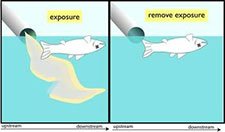Manipulation of Exposure
Concept
Manipulation of Exposure: Field experiments or management actions that increase or decrease exposure to a cause must increase or decrease the biological effect.

Click for more information

Click for more information
Examples
Consider the release of toxic substances from a known, unpermitted point source as a candidate cause of decreased mayfly (Ephemeroptera) taxonomic richness. What findings support or weaken the case for this toxic discharge as the cause, based on manipulation of exposure?
- Supporting evidence - Elimination of the unpermitted discharge results in increased mayfly taxonomic richness, similar to levels seen at unimpaired sites.
- Weakening evidence - Elimination of the unpermitted discharge has no noticeable effect on mayfly taxonomic richness.
How Do I Analyze the Data?
Statistical techniques used to evaluate manipulation of exposure include time series analysis; statistical tests such as the t-test, when manipulations are replicated and randomized; or statistical techniques based on rare events, such as the reappearance of sensitive taxa. Uncertainty in the data can be introduced when other events, natural factors, or other causes co-occur with the variable being manipulated; sampling designs such as before-after-control-impact (BACI) can help control for some of these factors. Recovery rates and treatment effectiveness also are sources of uncertainty and should be taken into account when analyzing results.
The most compelling manipulations are controlled field experiments that involve eliminating or reducing exposure to a source (e.g., fencing cattle out of a stream), changing the level of an agent (e.g., adding large woody debris to a stream), or artificially inducing exposure to a stressor (e.g., placing caged organisms at sites with varying levels of the suspected stressor). Ideally, changes in both the proximate stressor and the observed biological effect should be measured before and after manipulation. The power of this type of evidence comes from the control of exposure achieved by deliberate manipulation of events, and even the potential for replication. However, uncontrolled experiments (e.g., elimination of effluent during facility shutdown) also can be useful.
What Evidence Would Support or Weaken the Case for a Candidate Cause?
- Data showing that the effect decreases when or where exposure to the candidate cause is eliminated or reduced
- Data showing that the effect appears or increases when or where exposure to the candidate cause is initiated or increased
- Data showing that the effect persists when exposure to the candidate cause is removed is eliminated
- Data showing that the effect does not occur when exposure to the candidate cause is initiated
- Data showing, with a high degree of certainty, that the effect either does not change or does not change in the expected direction with manipulation of exposure.
How Do I Score the Evidence?
| Finding | Interpretation | Score |
|---|---|---|
| The effect is eliminated or reduced when exposure to the candidate cause is eliminated or reduced, OR the effect starts or increases when exposure to the candidate cause starts or increases. | This finding convincingly supports the case for the candidate cause, but it may be given a lower score if it could have resulted from other factors (e.g., removal of more than one agent or other unintended effects of the manipulation). | +++ |
| Changes in the effect after manipulation of the candidate cause are ambiguous. | This finding neither supports nor weakens the case for the candidate cause. | 0 |
| The effect is not eliminated or reduced when exposure to the candidate cause is eliminated or reduced, OR the effect does not start or increase when exposure to the candidate cause starts or increases. | This finding convincingly weakens the case for the candidate cause, because such manipulations can avoid confounding. However, effects may continue if there are impediments to recolonization or if another sufficient cause is present. | ---- |
| The effect is not eliminated or reduced when exposure to the candidate cause is eliminated or reduced, OR the effect is does not start or increase when exposure to the candidate cause starts or increases, and the evidence is indisputable. | This finding refutes the case for the candidate cause, given that data are based on a well-designed and well-performed study. | R |
Helpful Tips
- The power of this type of evidence resides in the deliberate manipulation of exposure, which can be designed to minimize confounding factors.
- Note the distinction between manipulation of exposure and variations in exposure that simply observed. Variation that is not deliberately manipulated is analyzed in terms of co-occurrence and stressor-response relationships from the field.
